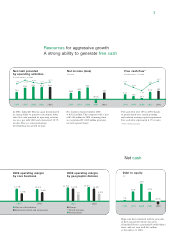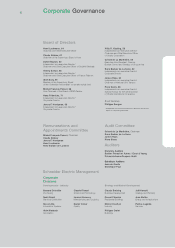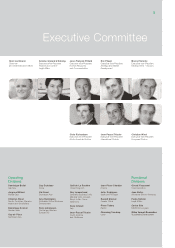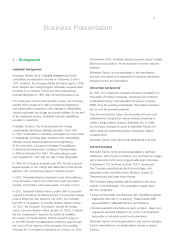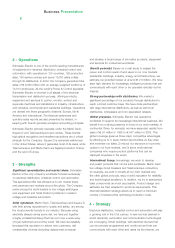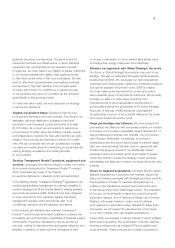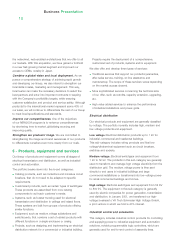APC 2002 Annual Report Download - page 15
Download and view the complete annual report
Please find page 15 of the 2002 APC annual report below. You can navigate through the pages in the report by either clicking on the pages listed below, or by using the keyword search tool below to find specific information within the annual report.
oversees one or several global accounts as part of SGBD.
The sponsor meets with a senior executive from the customer
company at least once a year to guarantee that Schneider
Electric understands and responds to the account’s specific
needs. In most cases, the relationship is formalized in a
comprehensive Program Alliance that sets out agreements
concerning prices and/or services, development and product
modifications. SGBD allows us to meet our global accounts’
needs more effectively, support our worldwide presence and
optimize sales with these major customers.
8 - Production
Schneider Electric has 192 production sites worldwide. Of
these, 55 are global facilities that manufacture products,
equipment and components for our three operating divisions.
We have 29 global plants in France, 19 in other European
countries, two in North America and five in the rest of the
world. In each country, production units are located as close
as possible to the markets they serve. Decisions on where to
set up local and global plants are generally based on criteria
such as access to suppliers, production costs, availability of a
trained workforce and logistics.
Although most of our products are built from standardized
components so that they can be sold around the world, they
are also adapted to local standards and requirements. Most of
our products and switchgear also include key functions such
as smart capabilities that allow for the transfer of images or
data. Design and esthetics are sometimes adapted to local
needs, but we focus heavily on standardizing key components
to achieve scale economies in production. A switch’s contact
mechanism, for example, will be standard but the outer shell,
which affects appearance and ergonomics, will vary from
region to region. This global/local approach helps us optimize
profitability.
While we do tailor our products and equipment to local
standards, the majority of our lineup complies with world-
recognized International Electrotechnical Commission (IEC)
standards. In North America, our products generally meet
standards set by the National Electrical Manufacturers
Association (NEMA) or American National Standards Institute
(ANSI), which are more widely used in the United States. Since
our products comply with the dominant standards in our host
markets, we are able to meet most of our customers’ needs.
Raw materials
We use raw materials such as carbon steel, aluminum, carbon
and thermoplastics, as well as electronic components to
manufacture our products. Materials such as carbon steel are
sourced from major international suppliers like Nippon Steel,
Lati and Mitsubishi, while components are supplied by large or
medium sized companies like Hussey Copper and Nypro. In
2002, raw material and component purchases totaled
2.8 billion. The prices of the raw materials we use
have been somewhat volatile.
Business Presentation
14


